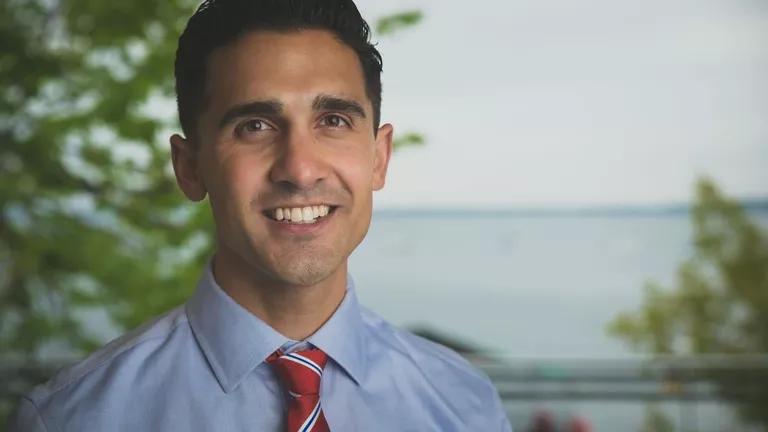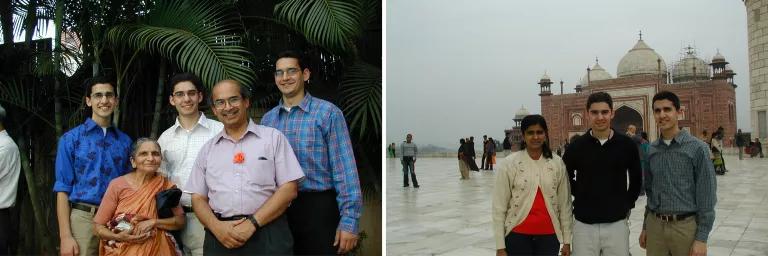Public Health Scientist and Advocate
Vijay Limaye is pushing for public health safeguards and policy solutions in service of the communities most vulnerable to the effects of climate change.

Vijay Limaye, climate and health scientist, NRDC Science Center
Environmental health scientist Vijay Limaye, PhD, has been sparking new conversations about the fundamental role of science in serving society. He’s also helping to update the stale stereotypes of what a scientist looks and speaks like, noting that, as a child, he didn’t see many scientists who looked like him speaking on the news. As an NRDC Science Center climate and health scientist, Limaye works to quantify, communicate, and translate information on the health risks worsened by climate change, focusing on the burdens of air pollution and extreme heat on vulnerable communities. Previously, Limaye worked as a scientist with the U.S. Environmental Protection Agency (EPA). He holds a bachelor’s degree from the University of California, Berkeley and a PhD in environmental epidemiology from the University of Wisconsin-Madison.
Much of your scientific research centers on the impacts of climate change on public health in both the United States and in India. What experiences motivated you to pursue this path?
My father was born in the Indian city of Pune, in the western state of Maharashtra. My family took a trip to visit our relatives back in 2004, my first time there. I remember arriving in the megacity of Mumbai and it being this amazingly bustling, vibrant, and welcoming place.
Simultaneously, I was really struck by the stark air pollution problems that I felt firsthand. Just seeing up close the thick haze from cars, mopeds, trash burning, and, of course, coal plants opened my eyes to the key connections between the environment and our well-being. It forced me to take a step back and consider my privilege. While I had the means to take actions to reduce my exposure, those options were unavailable to most.
That trip motivated me to pursue a career as a scientist working at the intersection of environmental policy and public health. I knew I wanted to focus on solutions and not just do research for research's sake.

Limaye (at left) with his grand-aunt, twin brother, father, and brother in Pune, India, 2005; Limaye (at right) with his twin brother and cousin at the Taj Mahal in Agra, India, 2005
What sort of research and solutions are you pursuing as a scientist at the intersection of climate and health?
At NRDC, I am focused on improving our understanding of local climate impacts and how they influence public health and health costs, and translating that knowledge into advocacy and policy. We work in India with a variety of leading local partners on extreme heat response and public health and resilience, especially in the city of Ahmedabad, in the western state of Gujarat. In 2010, when about 1,300 people died there in a severe heat wave, it was a wake-up call for the city leadership and local community to reduce the health risks of these searing temperatures that are only worsening every year. By 2013, the city had come together to launch South Asia’s first heat action plan, which deploys heat forecasts to proactively empower people with information about approaching heat waves and facilitates protective measures—especially for groups most vulnerable to heat.
That pioneering heat resilience planning has since scaled up to more than 100 cities across the country. It's also been an entry point into our city-level work to improve air quality, a project I helped strengthen during a 2018 trip to India with NRDC colleagues. Working with partners at the Indian Institute of Public Health Gandhinagar, I drew on research models from my days at the EPA to translate wonky technical information about air pollution into what it means for short- and long‑term health risks, such as heart attacks and reduced life expectancy. Alongside their pioneering heat action plans, Ahmedabad and Pune now have air information and response plans, which similarly use local data about air pollution and apply a health frame to it to make it more relevant and timely to folks.
How do you approach your work in the United States, where extreme heat waves and other climate-fueled disasters are a fact of life for some, but not all—and where there are more climate deniers among the public, in general?
When it comes to the United States, I work quite a bit on health cost research to describe all of the illnesses, costs, and health damages imposed by air pollution and climate change.
Our team published a study last fall on climate change and health costs that identified $10 billion in health damages inflicted on Americans during one year, from just a small sample of climate change–fueled events across 11 states. The events included a searing heat wave, multiple wildfires, ozone smog air pollution, spikes in allergenic pollen, extreme storms, outbreaks of West Nile virus and Lyme disease, and a major hurricane. I spent a year gathering and analyzing the data. All told, those climate-related events caused more than 20,000 hospitalizations, 17,000 emergency room visits, and 900 deaths. In one year.
According to the science we analyzed and synthesized, each of those health problems will worsen in severity and scope if we fail to address the climate crisis adequately. But the huge health costs of continuing inaction on climate are largely absent from the public’s understanding of climate change damages. While we hear some discussion about risks to infrastructure, property, or crops—things that are insured and repaired—there's much less conversation about the profound and expensive toll of human suffering, which is harder to put a dollar figure on. We undertook that study to fill a key gap in the science with new information that can strengthen advocacy on the urgent need for climate action.
Gina McCarthy, NRDC’s president, highlighted our study findings in her testimony before the House Select Committee on the Climate Crisis earlier this year. I was heartened that members of Congress were attentive to the stark findings and policy recommendations we outlined in our report. To me, that experience demonstrates the importance of advancing science to shape policies that protect people.
How have you felt as you’ve watched our federal government attack science and suppress scientific data that would help support and guide commonsense pollution controls?
At the EPA, I helped write the science assessments required by the Clean Air Act that summarize the latest evidence around the health effects of air pollution. Since I came to NRDC in 2017, I have seen firsthand how that science has been totally silenced and sidelined by the EPA’s current leadership and how the agency has tried to undermine the law from multiple angles, including, most recently, its decision to do nothing about the standards for the deadliest form of air pollution: fine particulate matter. Those microscopic particles come largely from fossil fuel burning, and they’re deadly because they penetrate deep into our lungs and, from there, can enter the bloodstream and nearly every organ in the body. All of the evidence indicates that there’s no safe level of air pollution.
But right now, the EPA is trying to say that it’s done enough, that it should hit the brakes on air quality control in the United States—and stall the lifesaving benefits of the Clean Air Act, just as that law turns 50 years old this year. It's a dangerous decision that will contribute to tens of thousands of deaths, emergency room trips, and hospitalizations in this country each year and profound suffering from heart and lung disease, at a time when Americans are already endangered by this pandemic.
I'm outraged. Decisions like these put all of us in harm’s way, not just those living in areas that we think of as having especially poor air quality, like Los Angeles or parts of the northeast. That’s why my NRDC colleagues and I have been pushing back hard to explain why the EPA's latest moves are illegal and enormously damaging to public health, while also contributing to skyrocketing health-care costs, and weakening our ability to confront the climate crisis head-on.
You’ve been analyzing research on the links between air pollution and COVID-19 mortality rates. What has that research shown?
Air pollution inflames our lungs, hardens our arteries, deposits toxins in our blood, and weakens our ability to fight infections. Preliminary research shows that long-term exposure to air pollution in the United States is associated with significantly higher COVID-19 death rates—and that finding aligns with mountains of evidence linking air pollution to breathing problems.
We know that people who suffer from pre-existing conditions are more likely to die from COVID-19, and that air pollution disproportionately burdens marginalized communities. Unfortunately, millions of people living in the United States already cope with these serious health issues, including asthma, chronic obstructive pulmonary disease, heart disease, and lung cancer.
We also know that more than half of Americans report financial hardship from medical bills—and certainly, because of the pandemic and its ongoing disruption of the economy, that proportion has only risen in recent months. The data tell us that millions of people are delaying or forgoing necessary medical care because they simply can't afford it. Unfortunately, delaying medical care can worsen existing health problems and make people even more vulnerable to disease.
What gives you hope for achieving a more equitable planet?
In public health, we’re working to strengthen the upstream factors—like racial equity, education, and environmental quality—that contribute to health and well-being. Those investments reap huge benefits, but we’ve neglected and underinvested in public health in this country for decades. Now is the time to correct that, to name and address the disparities that drive huge differences in health status, and to build systems worthy of our people.
More broadly, I'm encouraged by work at the state and local levels to understand and explain connections between climate change and health disparities, to respond to local priorities, and to shape solutions that can deliver real, tangible health and economic benefits for people right now.
I've seen in recent surveys that more Americans than ever before are aware and worried about the growing health risks of climate change. There’s no denying the truth that’s on display in 2020, all across the country—wildfires and searing heat raging out West, terrible flooding inundating the Midwest, and severe storms battering many eastern states. It’s a scary time. And it’s making me wonder: What kind of future do we want to build? A society that careens from one dangerous health crisis to the next and allows deadly problems to fester and grow, or one that enables all people to live long, healthy, and prosperous lives? Acting boldly to address the climate crisis is, without a doubt, a good prescription for our health.
This NRDC.org story is available for online republication by news media outlets or nonprofits under these conditions: The writer(s) must be credited with a byline; you must note prominently that the story was originally published by NRDC.org and link to the original; the story cannot be edited (beyond simple things such as grammar); you can’t resell the story in any form or grant republishing rights to other outlets; you can’t republish our material wholesale or automatically—you need to select stories individually; you can’t republish the photos or graphics on our site without specific permission; you should drop us a note to let us know when you’ve used one of our stories.

What Are the Effects of Climate Change?
Mutual Aid and Disaster Justice: “We Keep Us Safe”
Climate Change at the Doctor’s Office